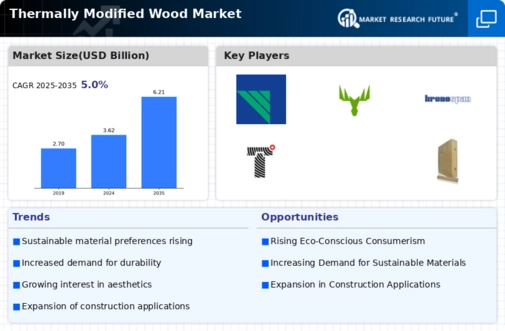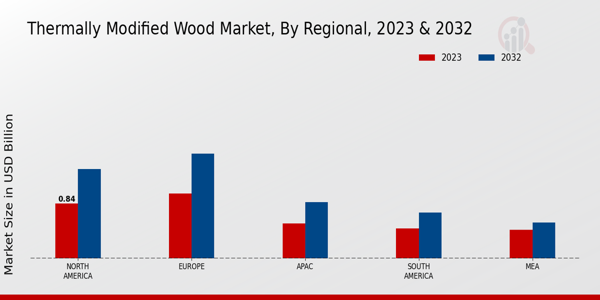Regulatory Support
Government regulations promoting the use of sustainable materials are a crucial driver for the Global Thermally Modified Wood Market Industry. Many countries are implementing policies that encourage the adoption of environmentally friendly building materials, which includes thermally modified wood. These regulations often provide incentives for builders and manufacturers to utilize sustainable options, thus fostering market growth. As the industry adapts to these regulatory frameworks, the market is projected to expand significantly, potentially reaching 6.21 USD Billion by 2035. This regulatory support not only enhances market viability but also aligns with global efforts to reduce carbon footprints in construction.
Rising Urbanization
The rapid pace of urbanization worldwide is a significant factor propelling the Global Thermally Modified Wood Market Industry. As urban areas expand, there is an increasing demand for sustainable building materials that can withstand the rigors of urban environments. Thermally modified wood, known for its durability and aesthetic appeal, is becoming a preferred choice among architects and builders. This trend is likely to contribute to the market's growth, with projections indicating a rise to 3.62 USD Billion in 2024. The urbanization trend suggests that as cities continue to grow, the demand for innovative and sustainable materials like thermally modified wood will also increase.
Sustainability Trends
The increasing emphasis on sustainability is a pivotal driver for the Global Thermally Modified Wood Market Industry. As consumers and businesses alike prioritize eco-friendly materials, thermally modified wood emerges as a viable alternative to traditional wood products. This wood undergoes a heat treatment process that enhances its durability and resistance to decay without the use of harmful chemicals. The market is projected to reach 3.62 USD Billion in 2024, reflecting a growing preference for sustainable building materials. Furthermore, the anticipated growth in eco-conscious construction practices is likely to bolster demand for thermally modified wood, aligning with global sustainability goals.
Market Growth Projections
The Global Thermally Modified Wood Market Industry is poised for substantial growth, with projections indicating a market size of 3.62 USD Billion in 2024 and an anticipated increase to 6.21 USD Billion by 2035. This growth trajectory, characterized by a CAGR of 5.02% from 2025 to 2035, reflects the increasing adoption of thermally modified wood across various sectors. Factors contributing to this growth include rising urbanization, technological advancements, and heightened consumer awareness regarding sustainability. As the market evolves, it is likely to witness further innovations and expansions, positioning thermally modified wood as a key player in the global building materials landscape.
Technological Advancements
Technological innovations in the processing of thermally modified wood significantly influence the Global Thermally Modified Wood Market Industry. Enhanced methods of heat treatment not only improve the wood's physical properties but also expand its applications in various sectors, including construction and furniture manufacturing. These advancements have led to increased efficiency in production, thereby reducing costs and waste. As the market evolves, it is expected to grow at a CAGR of 5.02% from 2025 to 2035, indicating a robust trajectory driven by ongoing technological improvements. This growth suggests that manufacturers are likely to invest in research and development to further refine these processes.
Consumer Awareness and Preferences
Growing consumer awareness regarding the benefits of thermally modified wood is a vital driver for the Global Thermally Modified Wood Market Industry. As individuals become more informed about the environmental and performance advantages of this material, their preferences shift towards sustainable options. This shift is reflected in the increasing demand for thermally modified wood in residential and commercial projects. The market's expansion is indicative of changing consumer attitudes, with expectations that it will reach 6.21 USD Billion by 2035. This evolving consumer landscape suggests that manufacturers must adapt to meet the rising expectations for quality and sustainability in wood products.





















Leave a Comment